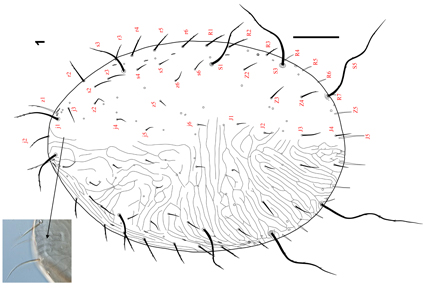Abstract
Cingulacarus Elsen is a monotypic genus of Trigynaspida based on C. gangeticus Elsen, collected from the scarabaeid beetle Scarabaeus gangeticus (Castelnau) (Col., Scarabaeidae) in the Democratic Republic of the Congo. Herein, a second species of the genus, C. kermanensis sp. nov. is described based on female and male specimens collected in southeastern Iran, in association with Oryctes elegans L. (Col., Scarabaeidae). The diagnosis of the genus Cingulacarus is revised, with a discussion of the impact on current generic keys for the family Diplogyniidae, and a proposal to eliminate the current subfamilial classification within that family.
References
- Elsen, P. (1974) Nouveaux genres et nouvelles espèces de Diplogyniidae (Acari: Mesostigmata) provenant d’un Hevea du Zaire. Acarologia, 16, 197–207.
- Elsen, P. (1975) Etude d’une collection de Celaenopsoidea africains (Acari: Mesostigmata). I. Famille Diplogyniidae Trägårdh, 1941: descriptions de genres et d’espèces nouveaux. Revue de Zoologie Africaine, 89, 337–375.
- Elsen, P. (1981) Etude d’une collection de Celaenopsoidea africains (Acari: Mesostigmata). II. Nouvelles descriptions de genres et d’espèces appartenant à la famille Diplogyniidae Trägårdh, 1941. Revue de Zoologie Africaine, 95, 570–607.
- Evans, G.O. (1963) Observations on the chaetotaxy of the legs in free-living Gamasina (Acari: Mesostigmata). Bulletin of the British Museum of Natural History, Zoology, 10, 277–303. https://doi.org/10.5962/bhl.part.20528
- Evans, G.O. (1965) The ontogenetic development of the chaetotaxy of the tarsi of legs II–IV in the Antennophorina (Acari: Mesostigmata). Annals and Magazine of Natural History, 13, 81–83. https://doi.org/10.1080/00222936508651543
- Hunter, P.E. (1993) Two new genera, Crassoseta, new genus and Brachysternopsis, new genus, of the family Diplogyniidae (Acari, Mesostigmata, Trigynaspida). Zoologica Scripta, 22, 91–99. https://doi.org/10.1111/j.1463-6409.1993.tb00343.x
- Johnston, D.E. & Fain, A. (1964) Ophiocelaeno sellnicki, a new genus and species of Diplogyniidae associated with snakes (Acari: Mesostigmata). Bulletin et Annales de la Société Royale d’Entomologie de Belgique, 100, 79–91.
- Kazemi, S., Klompen, H., Moraza, M.L., Kamali, K. & Saboori, A. (2008) A new species of Weiseronyssus Samšiňák 1962 (Acari: Mesostigmata: Diplogyniidae) from Iran, with a key for genera. Zootaxa, 1824 (1), 17–27. https://doi.org/10.11646/zootaxa.1824.1.2
- Lindquist, E.E. & Evans, G.O. (1965) Taxonomic concepts in the Ascidae, with a modified setal nomenclature for the idiosoma of the Gamasina (Acarina: Mesostigmata). Memoirs of the Entomological Society of Canada, 47, 1–64. https://doi.org/10.4039/entm9747fv
- Plumari, M. & Kazemi, S. (2012) Redescription and neotype designation of Lobogynium sudhiri (Datta) (Acari: Diplogyniidae), a mite associated with beetles of the genus Atholus (Thomson) (Coleoptera: Histeridae) in the Palaearctic region. Zootaxa, 3352 (1), 1–16. https://doi.org/10.11646/zootaxa.3352.1.1
- Rossi, W. (1994) A new contribution to the knowledge of the Laboulbeniales (Ascomycetes) from Sierra Leone. Accademia Nazionale dei Lincei, Quaderno, 267, 5–17
- Rossi, W. & Bernardi, M. (2018) New species and new records of Laboulbeniales (Ascomycota) from Thailand. Mycosphere, 9, 1151–1172. https://doi.org/10.5943/mycosphere/9/6/6
- Saito, H. (2022) A new species of Neolobogynium and new records of Lobogynium sudhiri of the mite family Diplogyniidae (Acari: Mesostigmata: Trigynaspida) phoretic on some beetls (Coleoptera: Histeridae, Synteliidae, and Geotrupidae) from Japan. Species Diversity, 27, 329–340. https://doi.org/10.12782/specdiv.27.329
- Samšiňák, K. (1962) Neue entomophili Acari aus China. Casopis Ceskoslovenske Spolecnosti entomologicke (Acta Soci-etatis entomologicae Cechosloveniae), 59, 186–204, 184 pls.
- Seeman, O.D. (2007) A new species of Paradiplogynium (Acari: Diplogyniidae) from Titanolabis colossea (Dohrn) (Dermaptera: Anisolabididae), Australia’s largest earwig. Zootaxa, 1386 (1), 31–38. https://doi.org/10.11646/zootaxa.1386.1.3
- Seeman, O.D. (2012) Diplogyniidae (Acari: Mesostigmata) associated with Panesthia cockroaches (Blattodea: Blaberidae). Zootaxa, 3163 (1), 33–53. https://doi.org/10.11646/zootaxa.3163.1.2
- Trägårdh, I. (1950) Studies on the Celaenopsidae, Diplogyniidae and Schizogyniidae (Acarina). Arkiv för Zoologi, Serie 2, 1, 361–451.
- Womersley, H. (1958) Some Acarina from Australia and New Guinea paraphagic upon millipedes and cockroaches, and on beetles of the family Passalidae. Pt 1. The family Diplogyniidae (Mesostigmata-Trigynaspida). Transactions of the Royal Society of South Australia, 81, 13–29.


